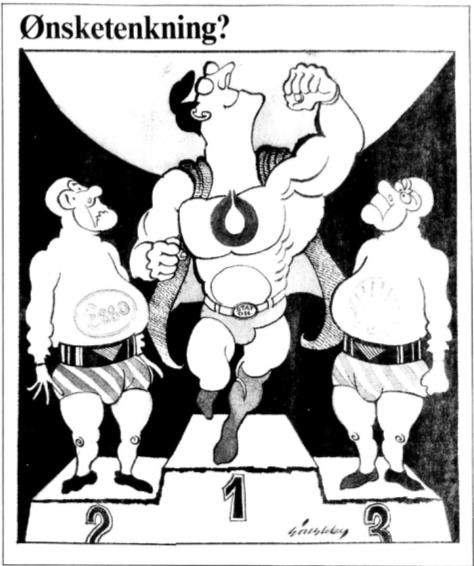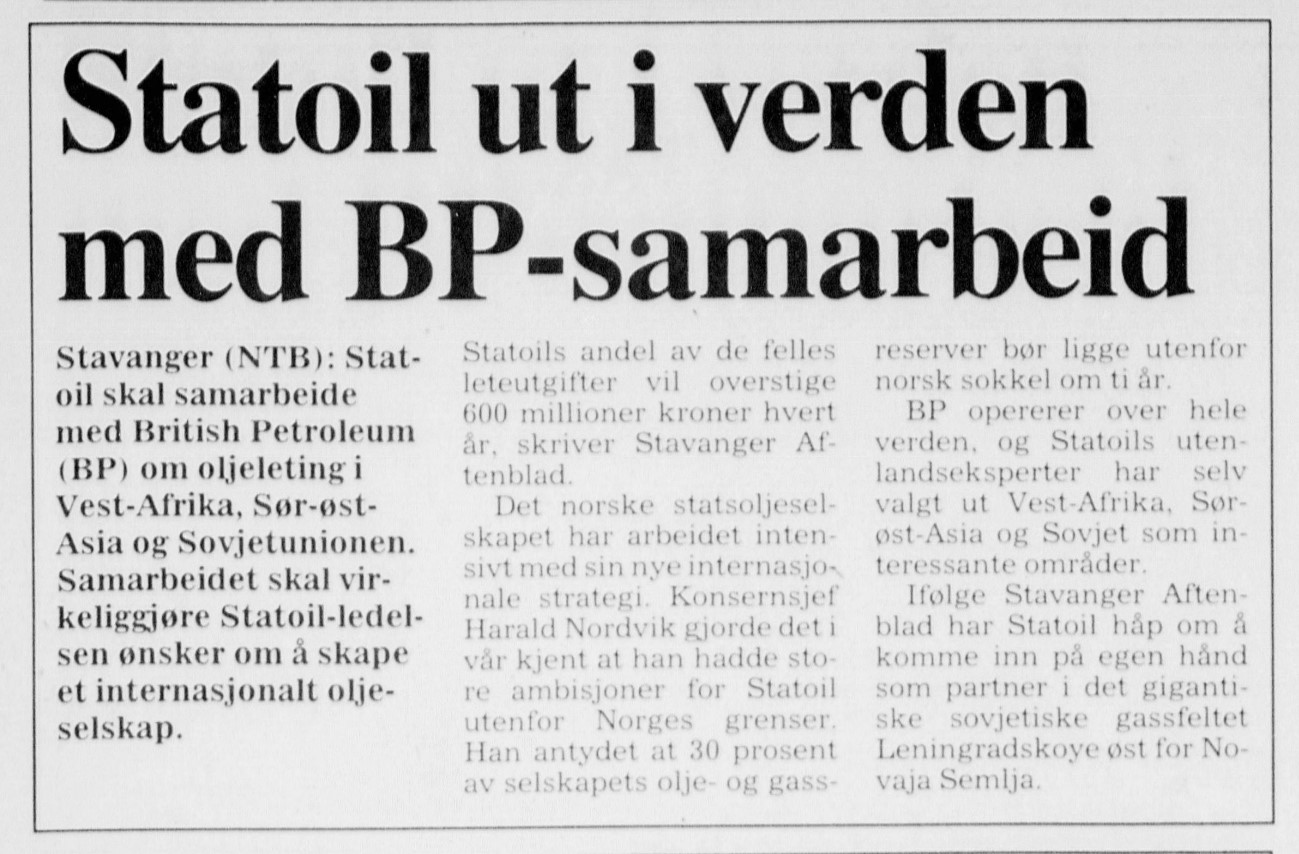Learning the ropes from BP

Harald Norvik became Statoil CEO in 1988 and quickly made it clear that he wanted the company to take a new direction. It would continue to grow not only in Norway, but also abroad. Norvik outlined his strategic goals when presenting an annual report in March 1990 which showed solid profits. Statoil was to become one of the world’s leading oil companies.[REMOVE]Fotnote: Morgenbladet, “Nye Statoil-ambisjoner”, 3 March 1990; Aftenposten, “Harald Norvik ut på en global shoppingtur,” 3 March 1990. The 1990s would be devoted to securing a foreign foothold, and acquiring both companies abroad and their petroleum reserves could be considered for securing assets, production and operatorships in fields on every continent. Few such acquisitions were actually made. Instead, Statoil opted for an alliance with BP.
This partnership reflected a powerful vision conceived and driven forward by Norvik and BP chair David Simon, who had forged a good relationship. It consisted originally of three components – international exploration and production (E&P), gas and research. The first of these proved the biggest success for both companies.

Statoil in 1990 was large in Norway but had little international experience. However, it was not wholly unfamiliar with the world oil industry. During the 1980s, the company had built up a solid base on the downstream side, primarily in other Nordic countries. It also had minor international engagements in E&P. The first of these had begun as early as 1979 with a consultancy assignment for the Chinese government. In 1984, Statoil had been given the green light by the Storting (parliament) for a gradual expansion of its international upstream engagement. Stakes were secured in the Dutch sector, a small holding in a Chinese offshore block, three licences off Denmark and several small interests on the UK continental shelf. Until the BP alliance, these commitments had been both sporadic and fortuitous. Statoil would now be trained up by this new collaborator to become an international oil company.
For its part, BP possessed long experience on the world stage but had run into money troubles. The company was operating at a loss and needed capital. It also suffered from a poor reputation in a number of countries from the days when it had been a tool of the British empire. During the 1980s, BP had been expelled from both Iran and Nigeria for political reasons.
Statoil was making substantial profits because of its favourable position on the Norwegian continental shelf. This cash could contribute the investment needed for a foreign commitment. As a Norwegian state-owned company, it also had a good reputation in many relevant environments, and could function as a door-opener in countries where BP and the UK were less trusted.
In addition, BP acquired political legitimacy and a softer image in these emerging markets, gained access to Statoil’s deepwater technology and experience, and secured substantial risk capital for its new and expensive commitment to frontier areas.
The main aim was nevertheless the same for both companies – internationalising their operations, particularly in E&P. Given the fall of the Berlin Wall in 1989, the collapse of the Soviet Union and the consequent opening-up of a number of companies to international capital, the timing appeared to be good.[REMOVE]Fotnote: Ryggvik, Helge, 2002. BP/Statoil alliansen: Et samarbeid til besvær, vol 16, working paper, centre for technology, innovation and culture, University of Oslo, print edn.
Plans – and what was dropped
As noted above, the agreement between the two companies included collaboration over selling gas in continental Europe and on research in addition to E&P.[REMOVE]Fotnote: Board item 5/90-5, Langsiktig samarbeid med BP Exploration Company Limited, Statoil.
Plans for joint gas sales were quickly shelved. The companies proved to have conflicting interests and to be bound by national strategies.
Cooperation on research and development (R&D) appeared initially successful, with investment committed to a big research programme. But this proved modest in relation to the R&D which the two companies pursued separately, and the collaboration was soon reduced to a minimum.[REMOVE]Fotnote: Ryggvik, Helge, op.cit.
That left E&P as the foundation for the alliance.
Where to become involved
BP and Statoil made a broad commitment together. It was decided that the alliance would operate in a large number of companies, such as Vietnam, Azerbaijan, Angola, Nigeria, DR Congo, Russia and China. But these ambitions were rapidly scaled back, with the last three countries in this list eventually dropped.[REMOVE]Fotnote: Ibid.
Opportunities for making discoveries in DR Congo were assessed as insufficient to justify an involvement. Results from commitments in China by both the alliance and other foreign companies were disappointing and, as part of a tightening in their joint activities, BP and Statoil resolved to pull out of the Chinese projects they were pursuing together.
Statoil nevertheless retained a presence in China, which offered the company a first opportunity to try out its own abilities as an operator in a foreign country.
Achieving agreements which gave sufficient security for investment was difficult in Russia. A Moscow office was opened, but the alliance pulled out at an early stage. Statoil nevertheless entered into a strategic alliance in 1996 with Gazprom on developing possible oil discoveries in the Pechora Sea off Siberia.[REMOVE]Fotnote: Board item 7/96-5: Redegjørelse for virksomheten, Statoil. Fellow Norwegian oil company Norsk Hydro joined this collaboration in 1998.[REMOVE]Fotnote: Board item 5/98-2: Konsernsjefen orienterer, Statoil.
Eventually, Statoil and BP were left with Azerbaijan and Kazakhstan around the Caspian, Angola and Nigeria in west Africa and Vietnam in Asia.[REMOVE]Fotnote: Ryggvik, Helge, op.cit.
BP was primarily to hold two-thirds of any licences interests secured, with Statoil receiving a third. All revenues and expenses were to be shared in the same proportions, and so were operatorships. The UK group played the main role in Azerbaijan, Vietnam and Angola, while Statoil became the operator in Nigeria. So the two-third/one-third division was not strictly applied.
The alliance was beset with collaboration difficulties, and its work was often crippled by internal antagonisms. It threatened to collapse on several occasions.
This partnership became less and less important for both companies during the 1990s. BP had sorted out its own organisation by downsizing and was back in profit, which made it less dependent on Statoil’s cash for continued growth. By the mid-1990s, its financial position was significantly improved. At the same time, Statoil had started establishing operations on its own account in various countries on several continents.[REMOVE]Fotnote: Ryggvik, Helge, 2009, Til siste dråpe, Oslo, Aschehoug: 242.
On its own two feet
The BP-Statoil alliance was dissolved after eight and a half years. It was announced in August 1998 that BP was to merge with (or, more accurately, take over) America’s Amoco oil company.

This meant that the partnership with Statoil was likely to be discontinued – and that happened in January 1999.
BP had gained little from the collaboration, with Statoil definitely securing the biggest benefit. For a relatively limited financial investment, it had secured interests in substantial oil fields in several of the world’s most promising oil regions. A close involvement with BP’s organisation had also given it first-hand experience of how one of the world’s most experienced multinational companies worked.
Becoming involved in several of the world’s most attractive oil provinces gave Statoil a status which also proved beneficial when it was operating on its own account.
Before entering into the agreement with BP, the company had acquired great technological expertise but lacked experience in operating globally. It was relatively unknown internationally and had problems winning acceptance from licensing authorities around the world. The collaboration with BP made its name known in important oil circles.

In addition, the alliance had given it a presence in several of the world’s most desirable newly opened oil regions. The company also gained important experience and self-confidence for an extensive foreign commitment on its own account. As early as the mid-1990s, Statoil devoted substantial resources through its international department to establishing itself in areas outside the alliance.
A 75-per-cent interest and the operatorship had been secured in China’s Lufeng oil field. This was small by Norwegian offshore standards and not a large source of revenue, but the operator role made it strategically important.
While Statoil also secured an interest in a Thai block, by far its biggest single commitment outside northern Europe was in Venezuela. This Latin American country opened up to foreign oil companies in the summer of 1995, and Statoil obtained a share in an oil field on land. That marked its first involvement in onshore production, which the company would use to show the world that it not only had advanced technological expertise but was also able to apply this cost-effectively under difficult conditions.
On the E&P side, therefore, the alliance became the breakthrough as an international company which the management had dreamt of.
arrow_backThe toughest strikeJoint venture with BP in Vietnamarrow_forward